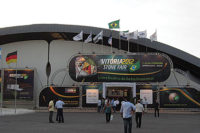
For the past 14 years, the International Marble & Granite Fair has taken place in the city of Cachoeiro de Itapemirim, Espirito Santo, Brazil. And while that region has a strong tradition in stoneworking, it has lacked the necessary infrastructure to make it a large-scale fair on an international level. This year, the show moved to Espirito Santo's capital of Vitoria, a thriving port city. And with the move came a solid attendance of buyers from Brazil and around the world, as evidenced by the large crowds of people who attended the event from February 19 to 22.
The 2003 edition of the event featured over 220 exhibitors. As the largest Brazilian producer of ornamental stones -- with 500 varieties of granite available in the state -- the Esp?to Santo location allowed visitors to the fair to make the most of their visit, as they had the opportunity to visit a broad range of stone suppliers within driving distance of the fairgrounds.
The organizers of the fair, Milanez & Milaneze, as well as promoters Sindirochas and Cetemag, pointed to the success of the Brazilian stone industry -- and Esp?to Santo in particular -- as a reason for the success of the fair. They report that an annual growth of 15% is expected annually until 2006, with 25,000 new jobs created in the sector over that period.
And with the growth of the stone industry, the region of Vitoria has become a hub for this activity on an international level. Shipping companies, custom agencies, forwarders, bonded warehouses and port authorities are using the trade fair as an opportunity to show the logistics facilities of the state, which is regarded as one of the best of Brazil for its export potential. In fact, the harbors of Espirito Santo exported an average 50% of the national production of raw marble and granite and more than 60% of production of finished material. These ports have all the necessary handling facilities for stone blocks and slabs.
The Vitoria location drew a number of large-scale producers from the local region as exhibitors, many of whom where exhibiting for the first time.
At a press conference before the fair -- conducted by Milanez & Milaneze, Sindirochas and Cetemag -- it was reported that the State of Espirito Santo produces 75,000 cubic meters of stone per year as well as 2 million square meters of finished slabs. Overall, production was comprised of 65% finished products in 2002, with the remaining 35% sold as blocks. But with advances in fabricating technology over the years, up to 90% of production will be sold as finished products within three years, according to Atilo Travaglia, president of Sindirochas.
The Brazilian exhibitors were not only limited to those from Espirito Santo. The Brazilian states of Pernambuco, Bahia, Rio de Janeiro and Minas Gerais were all represented at the event. In addition to stone suppliers who came from Brazil, the show also featured a large contingent of exhibitors from Italy, who arranged themselves in a national pavilion at the entrance to the exhibit hall. Exhibitors included suppliers of blocks, slabs, tiles and custom architectural stonework as well as fabricating equipment, tools and installation/maintenance products.
The event was expected to draw a crowd of 25,000 visitors, including members of the stone industry as well as architects and building professionals. Internationally, organizers expected 2,500 foreign visitors, an increase of 70% of the total in Cachoeiro de Itapemirim in 2002.
A localized edition of the fair will be held in Cachoeiro de Itapemirim this August, as organizers and promoters feel that the growth in exports from Brazil allows for two international fairs.

Sidebar:
Vitoria at a glance
Although the City of Vitoria is the State of Espirito Santo's capital, it remains largely unknown to many foreigners, who typically think of Rio de Janeiro and Sao Paulo as the primary Brazilian cities. However, with the move to Vitoria, the International Marble & Granite Fair offers a greatly improved infrastructure over Cachoeiro de Itapemirim, with better hotels, restaurants and road transport.To highlight some of Vitoria's benefits, the city's mayor, Luiz Paulo Vellozo Lucas, took the time to visit with some of the international trade press at the event. Pointing to the city's increased capacity for travelers, he pointed out that the city now has 3,000 hotel rooms, doubling the capacity of a few years ago. Additionally, a new convention center is expected to be in place by 2005. It will be located near the city's airport, which is also being updated. The city's highways and railways allow for easy connections to all major points in Brazil, and its vast port complex is considered among the best in all of South America.
The city of Vitoria, which is 452 years old, has a total of 300,000 people living in the city center, with a total of 1.5 million in the surrounding area. Of this total, more than half have come from outside the State of Espirito Santo, as they were attracted by the city's solid business opportunities.
